The two divisions, totaling nearly 22,000 men, were massed on the east bank of the river. With their superior numbers, arms and veteran officers, not to mention a long tradition of battlefield triumphs, they were confident of routing the ragtag band of rebels hiding in the woods and marshes on the other bank.
The signal was given, and the first artillery volley fired. The soldiers moved out, crossed the river—and marched into military history. Within three days, the two divisions were annihilated, and their commander's head was severed and sent back across the lines as a message: Don't come back.
This was not a battle from the worst days of the wars in Afghanistan or Iraq. It was the Battle of the Teutoburg Forest, nine years after the birth of Christ, in what is now northwestern Germany. It has been called "the battle that changed the course of history," because it marked forever the limits of the Roman Empire. Latin would never take root east of the Rhine.
Nearly 2,000 years later, America crossed its own Rhine of sorts, in Vietnam. Like the Romans, the U.S. military seemed virtually unbeatable, until it ventured into Southeast Asia. And like Rome's legions after 9 A.D., the U.S. Army would recover from the Indochina debacle, retool and fight again. But its political leaders failed to learn much from the expensive overreach in Vietnam, and soon losses and costly wins became more common than decisive victories.
To be sure, the United States won the Cold War without battling Soviet troops. But since its humiliating defeat in Vietnam, America has engaged in a string of significant military conflicts and emerged the clear winner in only two—ousting Saddam Hussein from Kuwait in 1991 and bombing Serbia to the negotiating table in 1995. More recently, even quick, dramatic triumphs in Iraq and Afghanistan have turned into grinding guerrilla wars, the seeds of which sprouted into the Islamic State, or ISIS. So on the 40th anniversary of Saigon's collapse, it seems timely to ask: Can America win a war? And what does winning look like in this seemingly endless era of murky counterinsurgencies, rogue nuclear states, Russian intrigues and Chinese encroachments?
In interviews with Newsweek, military experts, strategists, historians and former government officials say that absent some major miscalculation on the part of Russia, China or Iran, the wars America will fight in the foreseeable future will be protracted, low-intensity struggles with no clear victories. There will be no raising American flags over a vanquished enemy's capital, no parades. Wringing something resembling victory from the messes Washington is in now will require Americans to accept a new way of thinking about conflict.
For a country that boasts the best military in the world, the goal of containment may seem paradoxical or even defeatist. With annual defense budgets topping $500 billion since 9/11—more than any other country—the American military is unrivaled in its global reach, technological sophistication and destructive power. America's stealth bombers and cyberwarriors, by most accounts, can paralyze a major adversary. But in the kinds of wars the United States is now fighting, badass new weapons may be less important than creative thinking. Airstrikes and drones, not to mention the powerful electronic surveillance capabilities of the National Security Agency (NSA), haven't delivered victories over the Taliban or ISIS. Indeed, for all its technological know-how, the U.S. military hasn't even figured out how to neutralize improvised explosive devices—one of the least sophisticated yet deadliest weapons U.S. troops have faced on the battlefield.
Washington is tired of these foreign conflicts, the polls say. And U.S. strategists must now use other means to find something resembling victory. As Andrew Bacevich, a former Army colonel, Vietnam veteran and the resident military sage at Boston University, says, it's time to "acknowledge the limits of our power, to acknowledge the limited utility of force."

'A LONG, INDECISIVE STRUGGLE'
Lieutenant Colonel John Schwemmer was shocked when he returned to Iraq this year to train local troops for the fight against ISIS. When Schwemmer and the last American soldiers withdrew in 2011, the Iraqi army was in pretty good shape, he and other U.S. advisers thought. But when news came last summer that two Iraqi divisions collapsed in their first "battles" with ISIS, it was clear something was wrong. Only when Schwemmer and some 300 other U.S. trainer-advisers arrived a few months ago at Camp Taji, 20 miles north of Baghdad, did they realize how bad it was.
"It's pretty incredible," he told The New York Times in April. "I was kind of surprised. What training did they have after we left?" Not much, as it turned out. The Iraqi army looked good only on paper. As long as American and allied troops carried the brunt of the battle and the CIA mobilized Sunni tribes against Al-Qaeda, the Iraqi army's brittle core was largely unexposed. But after the Americans left, the endemic corruption of Iraq's officer corps, who stole food and pay from their troops, caught up with them. Few units were willing or able to fight when ISIS swept south last year.
If that sounds familiar, it should. It's the same situation American advisers have faced in counterinsurgency wars since Vietnam: U.S. proxies don't fight very well—but their enemies do. Neither the Viet Cong nor the Taliban needed foreign advisers to keep them in the battle.
In Iraq and Syria, as well as with the ongoing war in Afghanistan, the U.S. has dialed back its strategy. The objectives include protecting the U.S. homeland from terrorist attacks; preventing Iran from developing a nuclear weapon; defending long standing allies like Israel and Saudi Arabia; and ensuring the free flow of oil from the region. For President Barack Obama, those goals do not require large numbers of ground forces. Instead, he's adopted a light-footprint approach, hitting ISIS targets in Iraq and Syria from the air and contributing a few thousand military advisers to prepare Iraqi forces and Syrian rebels for ground action against the militants. Obama's Middle East strategy requires good intelligence, dogged diplomacy and a forward presence of U.S. naval and air forces. It also requires an ability to live with contradictions, such as providing air cover for Iranian proxies fighting ISIS in Iraq while supporting the Saudi campaign in Yemen against the Iranian-backed Houthis.
Is this enough to achieve U.S. goals in the region? Not according to hawks in both parties, who insist more U.S. ground troops are needed in Iraq, including those who would guide U.S. airstrikes against ISIS targets. They also want Obama to declare a no-fly zone over much of Syria to deny President Bashar Assad the use of his air force against anti-government rebels.

These defense hawks on Capitol Hill have made a lot of noise, but they haven't won over many military experts. Some current and former military commanders tell Newsweek Obama has roughly the right mix of military power to attain U.S. goals in the Middle East. The air campaign against ISIS, they say, has stalled its advance into Iraq, killed more than 6,000 militants and destroyed a significant portion of the U.S.-supplied tanks, artillery and other equipment that Iraqi troops left behind last June when they fled.
These experts caution that Obama's strategy is a long-term approach that will not produce quick, decisive results. Victory, they say, will be keeping ISIS out of Baghdad and preventing the group from launching a big terrorist attack on the U.S. homeland. "We're doing just enough to allow the Iraqis to keep ISIS engaged," says retired Lieutenant General Daniel Bolger, who commanded troops in Iraq and Afghanistan. "But this talk of destroying ISIS in the near term is wildly optimistic. This will be a long, indecisive struggle."
In an interview with Newsweek, former NSA and CIA Director and retired Air Force General Michael V. Hayden calls the campaign against terrorists, whether ISIS or Al-Qaeda, "all tactics, no strategy." "Targeted killings are a stopgap measure," Hayden says. "And you have to do them forever, unless you take advantage of the time and space they give you" for a political solution.
Bacevich, who lost a son in Iraq, defines victory as the restoration of "some reasonable stability" in the fractured Middle East and South Asia, so the United States doesn't have to be permanently mired in fighting there. But the days of lengthy occupations of tribal Muslim nations by overstretched U.S. forces, who have little familiarity with the local languages, culture, geography and history, are over. "Notice I didn't say a win is democracy, protecting women's rights or making ourselves the guarantor of Israeli military supremacy in the region," Bacevich adds. "I think that the best we can hope to get is a fairly modest solution."
That approach may require some radical adjustments in U.S. policy and rethinking who will receive billions of dollars in American aid. One such adjustment would be accepting that Iraq and Syria are failed states, and their Shiite governments no longer control the Sunnis, who occupy the Texas-sized tract of territory straddling those two countries. Baghdad and Damascus are unlikely to regain lost territory anytime soon—if ever. Iran now controls Iraq's Shiite areas, and with the entrenchment of ISIS and an increasingly independent Kurdistan, a new map of the Levant is taking shape. "Ain't coming back," Hayden says of the old borders, drawn in secret by England and France during World War I.
This means the U.S. may have to learn to live with ISIS in the same way it learned to deal with Cold War conflicts in Latin America, Asia and Africa, where proxies and occasionally U.S. forces fought to contain Soviet influence. The United States didn't win most of those conflicts; at best, it managed them to an acceptable conclusion. And just as Washington looked the other way when its Cold War proxies murdered innocents, it may need to find a level of comfort when its allies—whether it's Iraqi Shiite forces or Saudi Arabian forces in Yemen—kill civilians. One of the lessons of relying on allies in the Middle East and beyond is the limits of American power to mold their behavior according to our moral code.
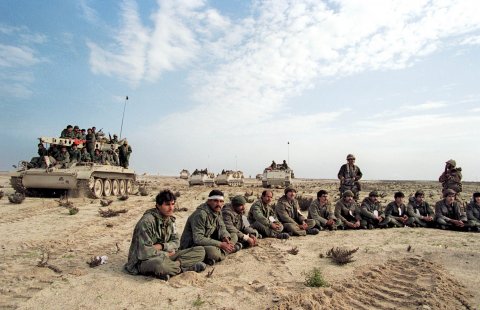
'WE'RE GOING TO KILL A LOT OF PEOPLE'
For all the blood, treasure and agony generated by the wars in Afghanistan, Iraq and Syria, these conflicts are undercards for the main event in the region: dealing with Iran. Stopping Tehran from developing nuclear weapons, Bacevich says, is just one part of Obama's strategy. "He is seeking a way to bring Iran back into the international order, so that Iran will play its proper role in regional politics, with the hope—and it's only a hope—that Iran will behave more or less responsibly, rather than trying to be a sponsor of Islamic revolution."
But should the nuclear negotiations fail—or Iran get caught cheating—the chances of a big-scale military showdown increase. Israeli Prime Minister Benjamin Netanyahu has often threatened to go it alone on Iran, but defense experts say this is unlikely. Israel couldn't carry out enough airstrikes to destroy all Iran's nuclear sites, defense analysts say, and Tehran could strike back by raining missiles on Tel Aviv, unleashing Hezbollah in Lebanon and dispatching suicide bombers to hit Jewish targets in and outside the country. The price for Israel would be very high.
It's been broadly assumed the United States would come to Israel's aid in any such conflict, but Admiral Patrick Walsh, a former commander of the U.S. Navy's 5th Fleet in the Persian Gulf, says support would depend on how the fight started. If Iran were the aggressor, Israel could count on America's help. But if Netanyahu mobilized for a preemptive attack, Washington might well disassociate itself from him. "You just can't presume unequivocal U.S. support for anything you say or do and [that] we'll always be there by your side," Walsh tells Newsweek.
He thinks the more likely international response to Iranian cheating would be a resumption of economic sanctions. But rainy-day plans are ready if sanctions are considered insufficient. While such plans remain highly classified, a blueprint for what a U.S. war against Iran might look like was published in 2012 by the Center for Strategic and International Studies, a Washington, D.C., think tank with a pipeline into the capital's national security establishment.
Anthony Cordesman, an influential defense analyst who co-authored the report, says the plan would entail an enormous air campaign, led by a strike force of 10 nuclear-capable B-2 bombers, as well as 90 advanced warplanes to protect the bombers, suppress enemy air defenses and jam Iranian radar and communications. The U.S. would also deploy tanker aircraft for midair refueling, he says. Then there are the aircraft carrier battle groups, special operations forces, drones, missile defense systems and surveillance aircraft and satellites the military would hurl into the offensive. In other words, it would be a big-time war, the likes of which have not been seen since the 2003 "shock and awe" bombing of Iraq.
Flying from the Indian Ocean island of Diego Garcia, every U.S. bomber would carry two 30,000-pound GBU-57 bunker busters, which can penetrate 200 feet of reinforced concrete to pulverize a deeply buried target. To prevent any preemptive or retaliatory fire against Israeli and American Arab allies in the Gulf, U.S. warplanes would have to take out Iran's eight ballistic missile bases, 15 missile production factories and 22 launch sites, Cordesman says. And the military would have to deploy special operations forces for behind-the-lines sabotage missions, reconnaissance and forward guidance for airstrikes against targets such as oil refineries, military bases, roads and bridges.
None of this would be easy, especially since Russia has lifted its self-imposed ban on the delivery of its powerful S-300 air defense missile system to Iran. The Iranian Revolutionary Guard might carry out its repeated threats to close the Strait of Hormuz, the strategic 21-mile-wide channel at the mouth of the Persian Gulf that controls the flow of 20 percent of the world's oil and gas supplies. Plus, Iran "can attack sporadically and unpredictably in a war of attrition or attempt to 'swarm' U.S. and Gulf naval forces" with small attack boats, Cordesman writes. As a consequence, the already chaotic Middle East could become even more destabilized, endangering the flow of oil from the region.
In the end, Cordesman says, the U.S. war effort would set back Iran's nuclear bomb program only by five to 10 years. And ordinary Iranians who oppose Tehran's extremist religious figures, Walsh and other authorities say, would rally to their nation's defense, ensuring a new generation's hatred of the United States.
How does that add up to a win?
"We had better think long and hard before going to war with Iran," says Bolger. "We could beat the hell out of them—in the air, on the sea and on the ground, and our war effort would be overwhelming and brutal. But we're going to kill a lot of people, and the Iranians will fight back desperately."
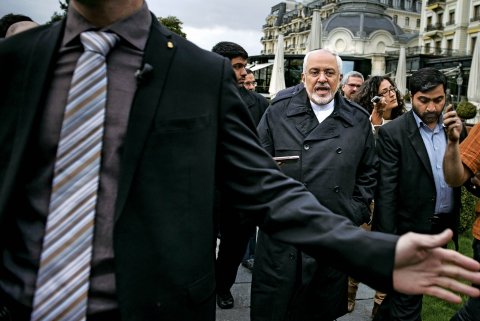
PUTIN'S MUSHROOM CLOUD
On April 7, a Russian Su-27 fighter jet buzzed a U.S. spy plane in international airspace over the Baltic Sea, coming within 20 feet and nearly causing a midair collision. The incident was the latest in a series of provocative—and increasingly dangerous—encounters between NATO and Russian forces.
Such confrontations are part of a broader campaign by Russian President Vladimir Putin to challenge NATO and the European Union in countries he regards as part of Russia's historic sphere of influence. Since he came to power in 2000, the former KGB agent has deployed an arsenal of new tactics to destabilize—and ultimately neutralize—once-Western-leaning former Soviet Republics and drive a wedge between EU and NATO members. The so-called hybrid war includes subversion by covert agents, the unacknowledged use of unmarked Russian special forces, the denial of Russian gas supplies as an economic weapon, a relentless propaganda campaign against the West and loan offers to economically strapped western European countries.
Putin already has begun to redraw the map of post-Soviet Russia. His troops now occupy Georgia's South Ossetia and Abkhazia regions, the Transnistria region of Moldova and, most recently, Ukraine's Crimean Peninsula. For the past year, Putin also has been covertly supporting a separatist war in eastern Ukraine, where preparations appear to be under way for a new offensive.
Crimea is gone, U.S. strategists concede, just like the chunks of Georgia that Russia bit off in 2008. And General Wesley Clark, a former NATO commander, and many others worry that there's no cohesive Western plan to stop Putin. The U.S.-led policy of slapping Russia with economic sanctions and helping train Ukrainian forces hasn't worked. Putin's ambitions in Ukraine, Clark says, can be curbed only by raising the cost of his aggression. The United States should ready a package of lethal aid to Ukraine, he says, including anti-tank missiles and special targeting radar, and then make it clear the weapons will be delivered to Kiev if Russia launches another offensive. "The question is, Will we do it in time?" Clark says. "It's much easier for us if we can support Ukraine now and check the growth of Putin's ambition in Ukraine than allow that ambition to swell after he's digested some more of Ukraine and turned to other targets."
Many analysts, however, think Putin's goals are more modest: to push back against NATO's aggressive eastward expansion after the collapse of the Soviet Union, to broaden Russia's sphere of influence on its borders and to recapture some of Moscow's standing in the world. "These questions of, Is Latvia next? Estonia next? are kind of overblown and overhyped," says Eerik Marmei, the Estonian ambassador to the United States.
Ultimately, the outline of a U.S. victory in Ukraine, which is not a member of NATO, looks like a political settlement that balances both Western and Russian interests. "I know what victory looks like there, and it's not the annihilation of the enemy," Hayden says. "The objective is to create an equilibrium that truly is sustainable." Hayden and others envision a new federal system of governance for Ukraine, one with broad provisions that would allow the eastern part of the country to align with Russia, as well as guarantees that Kiev won't join NATO. The goal, he says, is a "stable, modestly prosperous, modestly democratic Ukraine" devoid of Crimea and other eastern areas.
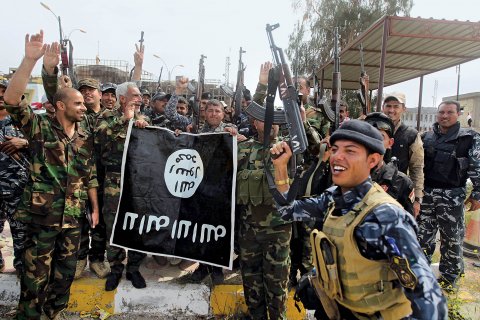
Yet Putin clearly has designs beyond Ukraine. He's been exploiting rifts within the European Union and NATO to create even deeper divisions. He's encouraged German worries about Russian gas supplies if sanctions continue. He's offered Greece loans on terms far more favorable than any eurozone bailout, as well as cheaper gas supplies, more Russian investment and tourism. He's even reached out to right-wing, nationalist, anti-European Union parties in France, Sweden, Finland, Hungary and Bulgaria.
Hovering over any direct clash with the Russians, of course, is the dark cloud of a nuclear conflict, and Putin has put those fears to good use. In March, Russia threatened to target Denmark with nukes if the Scandinavian nation became a member of NATO's missile-defense shield. Such threats only reinforce Putin's effort to make western Europeans believe that any attempt to blunt his designs on Ukraine risks a nuclear apocalypse.
Hayden, however, believes this is bluster. "Russia is not resurgent," he says. "They're running out of entrepreneurship, running out of democracy, running out of pluralism, running out of oil, running out of gas, running out of Russians—their birth rate is falling. I'm not worried about Russia in 10 to 15 years, I'm worried about Russia in zero to three years."
Other than sanctions and the threat of military aid to Ukraine, the only other answer to Russia is NATO. While the U.S. beefed up its presence in the Baltics after Russia's advance on Ukraine, many of Obama's critics would like to see him go to Narva, a city on Estonia's frontier with Russia, and declare, "It stops here." But with the U.S. military cutting back and many NATO members failing to meet pledges to devote 2 percent of their gross domestic product to defense spending, such a Reaganesque gesture seems unlikely. Even if Obama were to make such a demand, Putin might not take it seriously.
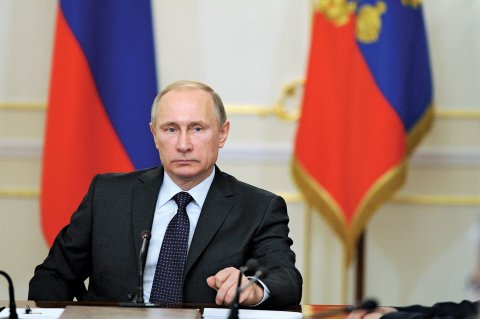
EVEN THE WINNERS LOSE
Just about every day now, fleets of Chinese marine surveillance ships and fishing trawlers swarm the waters near the Senkaku islands to underscore Beijing's territorial claims in the East China Sea. And each time, Japanese coast guard cutters try to order them out of the area, which Tokyo also claims. The Chinese rarely comply.
These bumper-car clashes with American allies in Asia, along with China's dramatic military buildup, have led some in Washington and Beijing to believe that war is inevitable. Critics counter that each side has so much to gain from peaceful competition, and so much to lose in an armed conflict, that war is unthinkable. Either way, the U.S. is watching China's muscle-flexing with caution and concern.
Twenty years ago, the idea that China might confront the United States militarily was outlandish. Back then, China publicly protested U.S. arms sales to Taiwan, which Beijing still claims as a renegade province, but privately acknowledged it was too weak to do anything about them. Today, Beijing not only has staked its claim to the South China and East China seas but also has the strength to back it up. U.S. naval intelligence has determined that China has formidable so-called area-denial weapons, including the hypersonic Dong Feng 21 missile, which is built to sink aircraft carriers. China's military buildup also includes a broad array of other medium- and long-range missiles, the unprecedented projection of naval power far from its coast, satellites that can blind America's space-based surveillance capabilities and a formidable cyberwar capacity that could wreak havoc on U.S. command-and-control networks. "They have come of age," says Walsh, who also commanded the U.S. Pacific fleet. In China's view, "they can rewrite the framework for a [U.S.] rules-based system in the Pacific."
In response, Obama's so-called Asia pivot includes a major realignment of U.S. military power that will eventually put 60 percent of the Navy's ships and submarines in the Pacific. The U.S. is also sending advanced warplanes like the F-22, the F-35 and long-range B-2 and B-52 bombers to the region, as well as additional warships equipped with Aegis missile defense systems. Defense Secretary Ashton Carter says new technologies are being developed to counter the Chinese buildup, including a long-range stealth bomber, a long-range anti-ship cruise missile and a rail gun that uses electromagnetic force to propel shells at higher speeds and greater effectiveness than conventional high explosives. Carter also says the Pentagon is developing new military capabilities for space and electronic warfare. "It will take decades—and let me repeat that: decades—for anyone to build the kind of military capability the United States possesses today," he said on the eve of his April trip to meet with allies in Asia.
Beijing has taken note and appears to be trying not to provoke a direct military confrontation with the United States, which has defense treaties with Japan, South Korea and the Philippines. Instead, it creeps up on cat's paws, surrounding disputed islands with its ships, keeping others at bay and in some territories building landing pads and strips. One day, there's just a lonely pile of rocks in the blue waters. The next, Beijing effectively controls it.
Such moves are fraught with the risks of miscalculation and swift escalation. Most military analysts agree that the United States, with its superior conventional and strategic forces, could send China reeling in a major military clash. But U.S. forces would also suffer significant losses. With its ship-killer missiles and spy satellites, China has come a long way from the human wave infantry attacks it used against U.S. forces during the Korean War. Over time, China's technological advances—some gained by stealing U.S. secrets—keep narrowing the gap in military superiority. China also has the advantage of cash and quantity. The country has greater capacity to build ever more ships and planes than the U.S.
Bacevich says a war between the U.S. and China would be "absurd," given the benefits of continued peaceful coexistence, not to mention the catastrophic death, destruction and jolt to the world order that a large-scale military clash would cause. But that doesn't mean friction can be avoided. After centuries of exploitation and marginalization by the West, China once again feels strong, and it has shown a nationalistic determination to plant its flag on the outer reaches of what it sees as its rightful defense zone.
If history is any guide, the prospects for peace don't look promising. Graham Allison, director of Harvard's Belfer Center for Science and International Affairs, notes that in 11 of 15 major cases since the year 1500 that involved a rising power emerging to challenge a ruling power, war was the result. But even the winners, in many cases, suffered cataclysmic losses.
The challenge for the West, Bacevich and others say, is to do a better job managing China's rise than it did Germany's in the first half of the 20th century. "Back in 1900 to 1905, the French, the Brits and the Russians failed to find the formula that would accommodate this rising German power," Bacevich says. "And the result was the catastrophe that exploded in 1914." And again in the 1930s.
A win for America in the western Pacific, therefore, would be managing the peace, much the same way the U.S. contained the Soviet Union and avoided a nuclear exchange in the Cold War. And as with the USSR, one tool for maintaining equilibrium is creating more economic, cultural and political ties to deepen China's relations with the United States. Another is to challenge Beijing to behave in ways that reflect what Chinese leaders say about themselves. After all, there's more to becoming a global power than exploiting resources in places like Sudan. "They say, 'We are somebody.' We say, 'Then act like somebody,'" says Hayden. "As a great power, you have to take some responsibility for sustaining the international system."
Beijing, of course, may ignore such lecturing. All the more reason, Hayden says, for Washington to underscore its readiness to defend it allies—with force. The point is "not to go to war with these people, but to make it harder for them to do something dumb."
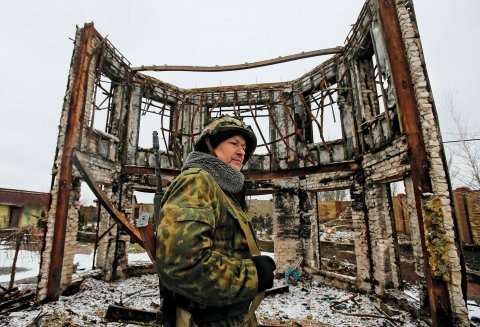
'THE WHOLE PLACE WILL GLOW IN THE DARK'
One place where Chinese and American interests have coincided is Korea. Ever since the end of the Korean War, both Beijing and Washington have worked hard to keep the peace on the peninsula. That's been a win for everybody, but especially South Korea, which has morphed into an industrial and technological powerhouse, especially since it threw off a military dictatorship more than 30 years ago.
But North Korea's Kim Jong Un, the latest Kim to run the family kleptocracy, is as volatile as his father and grandfather, brandishing nukes and missiles like plastic toys, flinging artillery shells at South Korean islands and periodically threatening to set the South "on fire."
Would Kim really dare to strike South Korea? Or launch a nuclear missile at Alaska? "Nothing is inconceivable," says a top consultant to the U.S. government on the Koreas, speaking to Newsweek on condition of anonymity to discuss the sensitive situation. "Under present circumstances, however, it's very unlikely [he] would want to launch an all-out attack on the South. He's concentrating on living standards and improving the economy. A war would be a huge setback, and it would take them another decade or two or three to dig out, even if they won."
"Deterrence still works in Korea," says Robert A. Manning, a former specialist on Korea and nuclear weapons in the State and Defense departments and office of the director of national intelligence. If Kim Jong Un massed troops on the border, he says, the U.S. would have plenty of time to warn him of the dire consequences of invading South Korea. "The bit of good news on North Korea is that they are not Al-Qaeda, not suicidal [and] hoping for 72 virgins," says Manning, now a senior fellow at the Atlantic Council in Washington, D.C. "The Kimster and friends value regime survival above all. They know that if they start any major conflict, the whole place will glow in the dark."
But loading our nukes to hit Pyongyang could also backfire. "The one scenario in which deterrence may not hold is a collapse scenario," Manning tells Newsweek. "If they are going down, they may want to take us with them." However unsatisfactory the status quo, he says, containment is probably the best we can hope for. Beijing seems determined to keep propping up the Kims, mainly to prevent millions of Korean refugees from flooding China. And as long as that remains unchanged, the Kims aren't going anywhere. "People have been predicting North Korea's collapse for 25 years," he says. "Don't hold your breath."

THE FOREVER WAR
After China, Russia, Iran and North Korea, everything else (including the tangle with ISIS) seems like housekeeping for the U.S. The shadow wars American special forces are waging against terrorists—from West Africa across Libya, Egypt, Syria and Iraq, down to Somalia, across Yemen to Afghanistan and Pakistan and all the way to the Philippines—involve no major ground units or potential big-power confrontations. They are the same kind of skirmishes Rome constantly fought to expand and protect its empire for 500 years.
In an April lecture at Harvard, CIA Director John Brennan didn't invoke the history of Rome, but he might as well have. "It's a long war, unfortunately," he said of the struggles to "degrade" Al-Qaeda, ISIS and their offshoots. "But it's been a war that has been in existence for millennia…and so this is going to be something, I think, that we're always going to have to be vigilant about."
Always vigilant, of course, translates as "permanent war, mostly at a low boil." Winning in this context means just staving off another major airline hijacking or 9/11-like attack—and certainly preventing a dirty bomb or nuclear weapon exploding on Western soil. Other attacks, such as the one on the Boston Marathon, launched by self-starting Islamic radicals, are difficult to prevent and may become the norm, intelligence officials acknowledge. Likewise, mass electronic surveillance and warrantless police searches will undoubtedly be with us for the foreseeable future, despite their debatable utility and the anger they provoke from civil libertarians. The same goes for the twin prongs of U.S. strategy abroad: drone strikes and partnering in counterterror missions with local regimes and tribal groups, which are often unreliable, discredited or unsavory.
In his book, Kill Chain: The Rise of the High-Tech Assassins, military analyst Andrew Cockburn highlights the career of Rex Rivolo, a Vietnam-era fighter pilot who became a leading space scientist and defense intellectual. A longtime skeptic of high technology's promise to deliver victory on the battlefield, Rivolo ended up working in a secret intelligence cell inside U.S. military headquarters in Baghdad. Drilling down into the stats, he discovered that knocking off so-called high-value targets using drone strikes and hunter-killer teams led to increased violence against U.S. and allied troops. "When we asked about going after the high-value individuals and what effect it was having, they'd say, 'Oh yeah, we killed that guy last month, and we're getting more IEDs than ever,'" Rivolo told Cockburn. "They all said the same thing, point-blank: 'Once you knock them off, a day later you have a new guy who's smarter, younger, more aggressive and is out for revenge.'"
The same is true in Pakistan, Yemen and now northern Iraq and Syria, the leading incubators of global terrorism. Hayden insists that drone strikes on Al-Qaeda were crucial in preventing another big attack on the United States. But while the top tiers of Osama bin Laden's group were decimated—and the leader himself eliminated in 2011—others took their places while the organization metastasized. Al-Qaeda and its ISIS rivals now compete for followers from Libya to Afghanistan. This cannot be considered a "win."
Talk to the men and women who have to fight these wars, and they all say the same thing: We can keep killing people, but to what end? In this forever war, the best the United States can hope for is the effective management of threats. That means a major adjustment involving Afghanistan may be looming. With U.S. forces slated to withdraw by the end of 2016, the future of the Kabul regime looks grim. At best, it faces a continued Taliban insurgency; at worst, a Taliban victory and a new civil war between Pashtuns in the south and ethnic Tajiks in the north. In either case, the central government's authority is unlikely to extend much beyond the capital. At some point, U.S. officials will be forced to question the wisdom of pouring more dollars into yet another failed state.
It also means Washington is likely to think twice before it intervenes militarily on humanitarian grounds, as it did in Libya in 2011. That intervention plunged the country into chaos, and a mosaic of militias now control different cities and regions. "These are problems that the people in the region are going to have to figure out how to solve," says Bacevich. "And they're not going to do it quickly; they're not going to do it easily; they are probably not going to do it without considerable bloodshed. But at the end of the day, they will have a better chance of solving their own problems than we will have a chance of imposing a solution on them."
Such was the lesson Rome eventually learned from its defeat in the Teutoburg Forest. Rome's legions took several more beatings east of the Rhine before their leaders decided the best way to reduce the threat of the Germanic tribes was to leave them to themselves. As the Roman historian Tacitus wrote, according to an analysis by the Dutch scholar Jona Lendering: "The Germanic tribes, left alone, would become divided again and cease to be dangerous."
That might well be the hard lesson America has to learn.





















